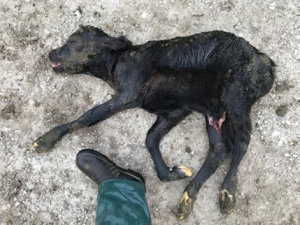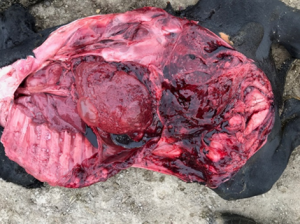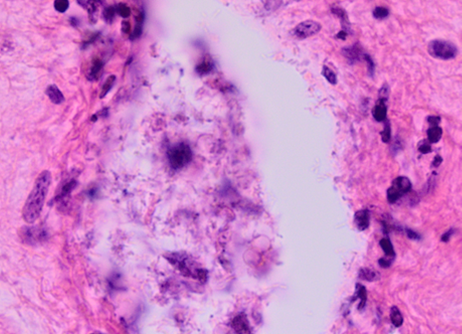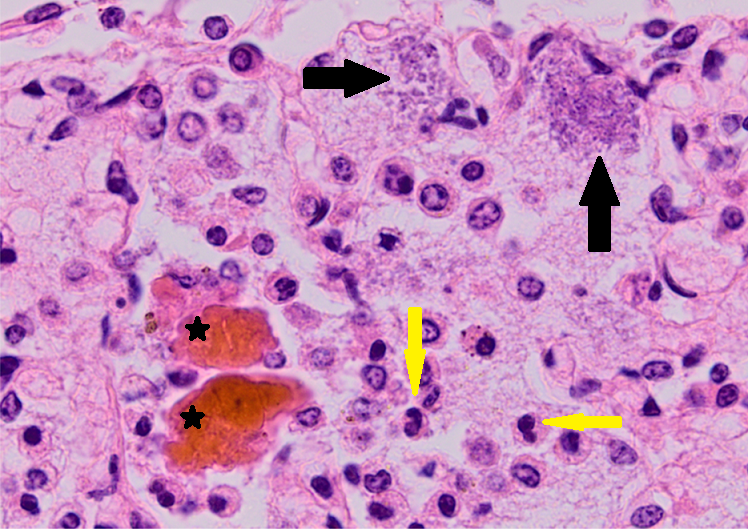LISA HULME-MOIR
This month has seen two cases from the Northland and Taranaki districts involving late-term abortions due to Salmonella Bovismorbificans.
In both instances, mixed-age dairy cattle were involved and in one case, eight of the nine cattle aborting did not show any observable clinical signs other than having dead near full-term calves. The aborted calves in this case appeared fresh with minimal gross changes other than non-specific haemorrhages through the skeletal muscle and organs and in one calf emphysematous areas through the liver (see Figures 1a and 1b). On histopathology, there were typical changes of necrosuppurative placentitis and acute bacteraemia and pneumonia of the fetus (Figures 2 and 3). A heavy growth of Salmonella Bovismorbificans was cultured from the foetal stomach contents.


Figures 1a and b (above): Near full-term calf aborted due to Salmonella Bovismorbificans. Non-specific haemorrhages were noted grossly with emphysematous areas over the liver indicative of autolysis. Many thanks to Nena Nepia for both of these images.
The second case presented with four cows dehydrated and scouring, two of which subsequently aborted. A heavy growth of Salmonella Bovismorbificans was obtained from the faeces of two of the cows.

The first case described above is a little unusual in the lack of clinical signs in the aborting cows. Most commonly Salmonella abortions are accompanied by signs of systemic illness, scouring and dehydration in the dam with abortion occurring either due to infection of the placenta and fetus after septicaemia; or prolonged pyrexia or endotoxaemia causing luteolysis without direct infection of the fetoplacental unit. It however has been noted that heifers aborting due to Salmonella Brandenburg in the South Island may or may not appear unwell.

Although historically Salmonella abortions have only been seen very sporadically in the North Island, it is worth considering this as a differential for abortions between 5-months to full-term and for stillbirths, given the zoonotic potential for vets and farm workers. In the South Island, we continue to see late-term abortions due to Salmonella Brandenburg. In 2019, 21 cases were diagnosed through our South Island laboratories between May and September, the majority of which were in first and occasionally second calvers.
22 July 2020 – Update regarding Salmonella Bovismorbificans from MPI:
Salmonellosis has long been recognised as an important cause of disease in cattle. However, based on the information MPI collects from the country’s veterinary diagnostic laboratories, we have noticed an increase in the reported incidence of Salmonellosis in dairy cattle since 2015, most notably involving the serotype Bovismorbificans.
Prior to 2015, S.Bovismorbificans was a rarely reported serotype in cattle (2003-2014 n=8). Since 2015, we have noted an increase in reported cases (2015-present n=834). Because our data relating to impact rely on the information provided in veterinary submission forms (and some fields are often not completed), it is difficult to make an estimate regarding the impact of this serotype on the outbreak farms.
Sporadic cases and outbreaks have been reported in both adult dairy cattle and in calves. While cases do get reported year round, the majority occur in spring with a smaller peak occurring early autumn. Most regions of the country have experienced cases, but the main areas from which cases have been reported are the Waikato, Manawatu-Whanganui and Taranaki, with increasing reports of cases also from Canterbury and the Bay of Plenty.
The extent of the issue is difficult to estimate in sheep, due to a limited amount of data; but, it is clear that there has been an increased number of reports in this species also.
To help us better understand the impact of S. Bovismorbificans, we ask veterinarians to ensure they complete all the fields on laboratory submission forms, especially the fields that relate to number of animals at risk, number affected and number dead.
Along with this increasing trend in animal cases, ESR has reported cases of S. Bovismorbificans in humans. This emphasises the importance of this organism (and Salmonella generally) as a zoonotic pathogen and a potential risk to those working with affected animals.
